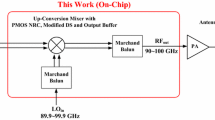Abstract
This paper presents a down-conversion active mixer with improved performance for direct conversion receivers in wireless local area networks. The effect of negative admittance on the Gilbert cell mixer performance is investigated in terms of flicker noise, conversion gain, and linearity. The proposed negative admittance is implemented using a modified negative capacitance connected in parallel to a negative resistance, which exhibits a high degree of freedom to achieve high negative capacitance along with low negative resistance. The proposed mixer is designed and simulated using TSMC 0.18 µm CMOS technology in Cadence Spectre-RF at the input frequency of 2.4 GHz and intermediate frequency of 10 MHz. Post-layout simulation results show using the negative admittance can improve the flicker noise more than 16.7 dB at the frequency of 1 kHz. The proposed mixer exhibits a conversion gain of 19.3 dB and a flicker noise corner frequency of 5 kHz. The double-side band noise figure is 7.57 dB at the output frequency of 10 MHz, and the third-order intermodulation intercept point (IIP3) is − 7.5 dBm. The power dissipation is 13.6 mW from the power supply of 1.8 V. Moreover, the linearity of the proposed mixer can be enhanced by choosing the proper values for transconductance of switching quad and negative resistance so that it achieves the IIP3 of + 7.9 dBm with the conversion gain of 7.6 dB.



























Similar content being viewed by others
References
A. Bijari, S. Zandian, Linearity improvement in a CMOS down-conversion active mixer for WLAN applications. Analog. Integr. Circuits Signal Process. 100, 483–493 (2019)
R. Brederlow, W. Weber, C. Dahl, D. Schmitt-Landsiedel, R. Thewes, Low-frequency noise of integrated poly-silicon resistors. IEEE Trans. Electron Devices 48, 1180–1187 (2001)
R. Caverly, CMOS RFIC Design Principles, Artech House, Inc. (2007)
C.H. Chen, P.Y. Chiang, C.F. Jou, A low voltage mixer with improved noise figure. IEEE Microw. Wirel. Compon. Lett. 19, 92–94 (2009)
W. Cheng, A.J. Annema, J.A. Croon, B. Nauta, Noise and nonlinearity modeling of active mixers for fast and accurate estimation. IEEE Trans. Circuits Syst. I Regul. Pap. 58, 276–289 (2011)
W. Cheng, A.J. Annema, G.J.M. Wienk, B. Nauta, A wideband IM3 cancellation technique using negative impedance for LNAs with cascode topology. Dig. Pap. IEEE Radio Freq. Integr. Circuits Symp. (2012). https://doi.org/10.1109/RFIC.2012.6242221
W. Cheng, A.J. Annema, G.J.M. Wienk, B. Nauta, A flicker noise/IM3 cancellation technique for active mixer using negative impedance. IEEE J. Solid-State Circuits 48, 2390–2402 (2013)
H. Darabi, J. Chiu, A noise cancellation technique in active RF-CMOS mixers. IEEE J. Solid-State Circuits 40, 2628–2632 (2005)
H. Darabi, A.A. Abidi, Noise in RF-CMOS mixers: a simple physical model. IEEE J. Solid-State Circuits 35, 15–25 (2000)
S. Galal, B. Razavi, 40-Gb/s amplifier and ESD protection circuit in 0.18-μm CMOS technology. IEEE J. Solid-State Circuits 39, 2389–2396 (2004)
A. Ghadiri, K. Moez, Wideband active inductor and negative capacitance for broadband rf and microwave applications. IEEE Trans. Comp. Packag. Manuf. Technol. 4, 1808–1814 (2014)
A. Ghadiri, K. Moez, Gain-enhanced distributed amplifier using negative capacitance. IEEE Trans. Circuits Syst. I Regul. Pap. 57, 2834–2843 (2010)
S.C. Gladson, S. Vijayalakshmi, M.S. Lakshmi, M. Bhaskar, Linearity improvement of RF mixer using double-linearization for 5 GHz applications (J. Electron. Commun, AEU Int, 2019). https://doi.org/10.1016/j.aeue.2019.152856
S.C. Gladson, M. Bhaskar, R. Praveen, S. Sudharsan, A 261-µW ultra-low power RF mixer with 26-dBm IIP3 using complementary pre-distortion technique for IEEE 802.15.4 applications. AEU Int. J. Electron. Commun. 107, 70–82 (2019)
H.B. Kia, A.K. A’ain, A high gain and low flicker noise CMOS mixer with low flicker noise corner frequency using tunable differential active inductor. Wirel. Pers. Commun. 79, 599–610 (2014)
J.-H. Kim, H.-W. An, T.-Y. Yun, A low-noise WLAN mixer using switched biasing technique. IEEE Microw. Wirel. Comp. Lett. 19, 650–652 (2009)
T.W. Kim, B. Kim, K. Lee, Highly linear receiver front-end adopting MOSFET transconductance linearization by multiple gated transistors. IEEE J. Solid-State Circuits 39, 223–229 (2004)
C. Kim, H. Son, B. Kang, A 2.4 GHz current-reused CMOS balun-mixer. IEEE Microw. Wirel. Compon. Lett. 19, 464–466 (2009)
J. Lee, T. Yun, Low-flicker-noise and high-gain mixer using a dynamic current-bleeding technique. IEEE Microw. Wirel. Compon. Lett. 27, 733–735 (2017)
M.-M. Mohsenpour, C.E. Saavedra, Method to improve the linearity of active commutating mixers using dynamic current injection. IEEE Trans. Microw. Theory Tech. 64, 4624–4631 (2016)
H. Oh, J. Kim, J. Lim, C. Kim, A 2.4-GHz high conversion gain passive mixer using Q-boosted π-type LCL matching networks in 90-nm CMOS. IEEE Microw. Wirel. Components Lett. 27, 736–738 (2017)
J. Park, C. Lee, B. Kim, J. Laskar, Design and analysis of low flicker-noise CMOS mixers for direct-conversion receivers. IEEE Trans. Microw. Theory Tech. 54, 4372–4380 (2006)
M. Parvizi, A. Nabavi, Low-power highly linear UWB CMOS mixer with simultaneous second- and third-order distortion cancellation. Microelectron. J. 41, 1–8 (2010)
R.S. Pullela, T. Sowlati, D. Rozenblit, Low flicker-noise quadrature mixer topology. Dig. Tech. Pap. IEEE Int. Solid-State Circuits Conf. (2006). https://doi.org/10.1109/ISSCC.2006.1696244
B. Razavi, RF Microelectronics (Prentice hall, New Jersey, 1998)
D.-H. Seo, J.-Y. Lee, T.-Y. Yun, Active and passive combined mixer for low flicker noise and low dc offset. IEEE Microw. Wirel. Compon. Lett. 25, 463–465 (2015)
J. Yoon, H. Kim, C. Park, J. Yang, H. Song, S. Lee, B. Kim, A new RF CMOS Gilbert mixer with improved noise figure and linearity. IEEE Trans. Microw. Theory Tech. 56, 626–631 (2008)
Author information
Authors and Affiliations
Corresponding author
Additional information
Publisher's Note
Springer Nature remains neutral with regard to jurisdictional claims in published maps and institutional affiliations.
Rights and permissions
About this article
Cite this article
Amirabadizadeh, S., Bijari, A., Alizadeh, H. et al. Performance Improvement of a Down-Conversion Active Mixer Using Negative Admittance. Circuits Syst Signal Process 40, 22–49 (2021). https://doi.org/10.1007/s00034-020-01477-9
Received:
Revised:
Accepted:
Published:
Issue Date:
DOI: https://doi.org/10.1007/s00034-020-01477-9




